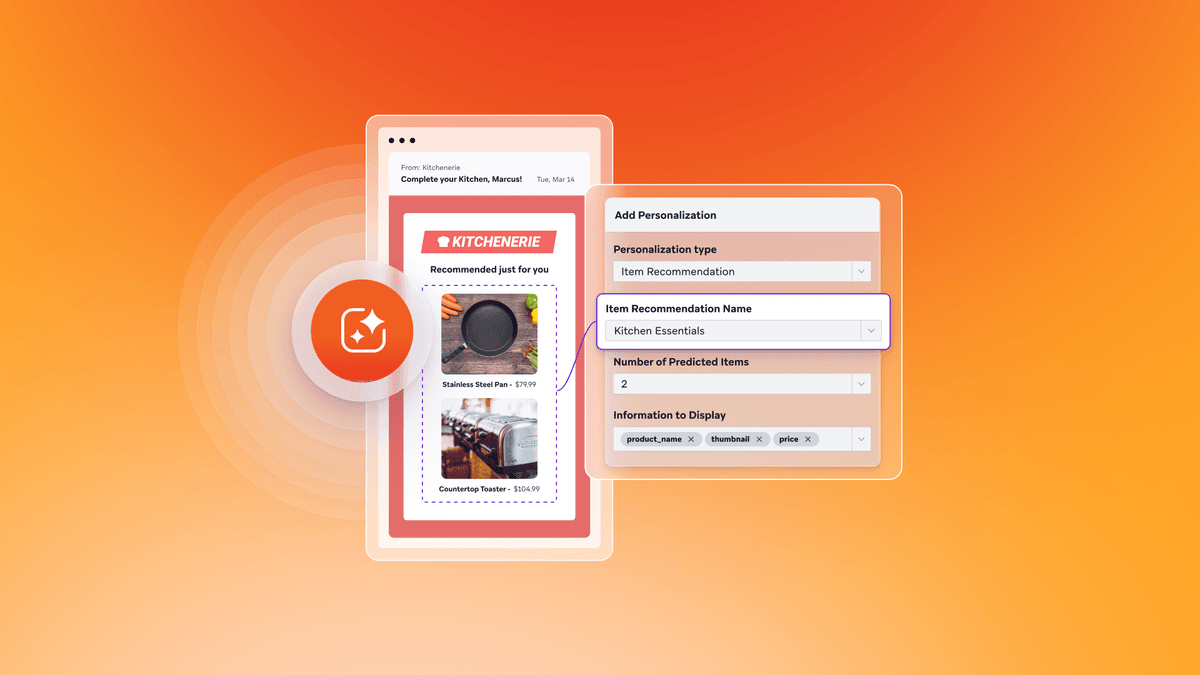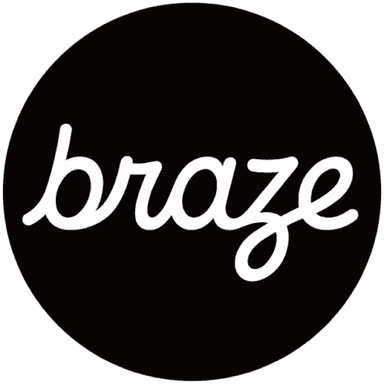AI agents in marketing: What they are and how they power smarter journeys
Published on August 06, 2025/Last edited on August 06, 2025/8 min read


Team Braze
While it seems that AI has just recently jumped to the forefront, in truth, marketers have long relied on similar automation tools to work faster and scale smarter. But every time technology advances, consumer expectations change too, and it can be hard to keep up. AI agents, or autonomous, decision-making systems, can help by acting in real time, personalizing and optimizing customer engagement for messages, moments, and channels based on individual customer behavior.
AI agents take the pressure off manual execution, and unlock new possibilities for strategic engagement. They can help make the best campaign decision for each individual on their own, elevating marketers to the strategic conductors of their business. And when integrated into platforms like Braze, they can act fast and responsibly, with human assistance and guardrails built into every step.
Contents
- What are AI agents in marketing?
- How AI agents work
- AI agents in Braze
- Keeping the marketer in the loop (and in control)
- Final thoughts on AI agents and the future of engagement
- FAQs about AI agents in marketing
What are AI agents in marketing?
AI agents are intelligent software systems designed to make decisions and take action autonomously, with the objective of achieving a specific goal. In a marketing context, they’re the behind-the-scenes operators that evaluate data, uncover insight and make decisions on the most relevant, real-time experiences for each customer at scale.
Unlike traditional automation, which can follow pre-defined journeys, AI agents learn and adapt to personalize experiences for each individual. They decide who to engage, when to do it, and what to say—based on behavior, preferences, and reinforcement learning models. Think of creating for each customer the cross-channel journey that will most likely convert them from a free-trial user to premium subscribers. At Braze, we think of AI agents as decision-makers that can help uncover the experience that is most likely to resonate for each individual. They do not just make inferences but help make the decision that will be most impactful for each customer.
How AI agents work
Let’s say you are trying to maximize upsells by the end of the quarter. You could send the same message to your customers, or even create a few different variants to send to different segments. Or, with an Agentic AI, you can send each user a message personalized to what will most likely lead to a conversion.
AI agents assess live inputs—like user behavior, engagement history, and predicted preferences—and can tailor messages to each unique individual, based on what they want right now. No need for marketers to micromanage every step. Just timely, relevant communication that adapts as the customer journey evolves.
In practice, this means:
- Personalizing the campaign experience on a 1:1 level
- Sending the right offers to maximize goals
- Dictating the mediums and frequency of messaging
- Driving the objectives that are most important to your brand
And because AI agents work continuously in the background, they can make thousands of micro-adjustments across a campaign or journey at scale—optimizing decisions across millions of customer touchpoints.
AI agents in Braze
AI agents are already reshaping how marketers run campaigns. Working in the background, they make thousands of small, real-time decisions that improve performance—without the need for constant human oversight.
Here are key ways Braze utilizes agents:
Personalize every aspect of campaigns through AI decisioning
AI decisioning acts as the brain that sits atop a brand’s tech stack, transforming customer data into 1:1 personalization across the customer lifecycle. OfferFit by Braze uses AI decisioning agents to maximize a chosen business metric through perpetual learning, experimentation, and 1:1 personalization at scale. How? OfferFit by Braze uses first-party data to create unique customer profiles to understand what motivates individuals to convert, then constantly experiments with send-times, content, images, and channels to find the ideal mix for everyone.
Through experimentation AI decisioning agents constantly learn, and respond to changes in, consumer preferences or buying patterns in real-time. By adapting, OfferFit by Braze helps increase engagement, conversions, and tangible business metrics like customer lifetime value in the process.
Personalize experiences to each unique customer, even as they change
By allowing marketers to set high-level guidelines, Project Catalyst (currently in Beta) is designed to generate variants for each component of the customer experience—such as subject lines, messaging tone, offers, and channel mix—and use AI agents to help personalize the experience so that each interaction resonates on an individual level.
While OfferFit is designed to drive improvement in a specific business metric across users, Project Catalyst is focused on allowing agents to build individualized campaigns based on marketer inputs.

With Project Catalyst, marketers will be able to experiment and personalize their outreach in dynamic new ways. For instance, if a retail brand aims to re-engage lapsing customers, Project Catalyst can craft distinct experiences for each individual based on their unique behaviors and preferences. One customer might receive a humorous email with a specific offer, while another might get a persuasive push notification with a different incentive. This level of customization empowers marketers to make informed adjustments and optimize outcomes continuously.
Optimize experiences through experimentation
Braze Intelligent Selection is designed to optimize the performance of recurring campaigns by analyzing message variants and adjusting user distribution based on real-time data. Intelligent Selection chooses the most successful messages to send to a larger audience, while underperforming variants are sent to fewer users. This dynamic adjustment is powered by a sophisticated model that accounts for performance differences, eliminating the influence of random chance.
With Intelligent Selection, marketers can shift campaign traffic toward winning variants, gradually increasing the reach of the best-performing messages without compromising statistical integrity. This feature allows for more frequent testing and faster identification of high-performing variants. Ideal for campaigns that are sent multiple times, Intelligent Selection harnesses early performance data to optimize messaging effectively.
Keeping the marketer in the loop (and in control)
In modern marketing platforms, using AI agents can spark the fear of marketers losing control, but that’s not the case. AI agents help teams to gain more time, clarity, and strategic space, which allows brands to scale and still keep the final say in every marketing decision.
That’s why the most effective AI agents are designed with transparency and guardrails built in. AI Agents can work within marketers’ defined guardrails, leveraging pre-approved content, and using only the channels, mediums, and parameters a marketer has specified. Additionally, Agentic AI should be leveraged in partnership with human expert services who can help continuously configure and finetune the decisions that AI agents can make.
This balance—automation plus accountability—means AI agents don’t replace marketers. They free them up and even elevate them to the strategic conductors of their business. You're still the one deciding the journey, the message, and the strategy. The agents help take your inputs so each customer receives the experiences most likely to resonate with them.
That said, speed and efficiency only go so far. Responsible AI in marketing also means building in transparency, aligning decisions with brand values, and giving marketers tools to adapt as customer expectations evolve. The strongest AI agents are the ones that support human creativity, not override it.
Smarter customer journeys happen when machines handle the complexity, and marketers stay focused on the strategy that drives long-term growth.
Final thoughts on AI agents and the future of engagement
AI agents are changing how marketers work—not by replacing the strategy, but by uncovering insights at massive scale, and making decisions that help personalize at the individual level. They step in where it makes sense, acting on context, intent, and predictions so teams can spend less time reacting and more time shaping the customer experience.
These tools help brands move with their customer by analyzing datasets and making decisions that maximize outcomes out from thousands of touchpoints. This helps marketers respond and react in real time, adapting across channels, and creating moments that feel authentic, not automated. And with the right oversight, AI agents become a way of extending the capabilities of marketer
As these capabilities continue to evolve, one thing remains true. The smartest journeys are the ones that balance automation with intention, leveraging AI for speed, simplicity and scale, and people for purpose, creativity and strategy.
Forward-Looking Statements
This blog post contains “forward-looking statements” within the meaning of the “safe harbor” provisions of the Private Securities Litigation Reform Act of 1995, including but not limited to, statements regarding the development, performance of and expected benefits from Braze agentic AI products and features. These forward-looking statements are based on the current assumptions, expectations and beliefs of Braze, and are subject to substantial risks, uncertainties and changes in circumstances that may cause actual results, performance or achievements to be materially different from any future results, performance or achievements expressed or implied by the forward-looking statements. Further information on potential factors that could affect Braze results are included in the Braze Quarterly Report on Form 10-Q for the fiscal quarter ended April 30, 2025, filed with the U.S. Securities and Exchange Commission on June 6, 2025, and the other public filings of Braze with the U.S. Securities and Exchange Commission. The forward-looking statements included in this blog post represent the views of Braze only as of the date of this blog post, and Braze assumes no obligation, and does not intend to update these forward-looking statements, except as required by law.
FAQs about AI agents in marketing
AI agents in marketing are autonomous systems that perceive their environment, make decisions, and take action autonomously to achieve a specific goal. How do AI agents work in customer engagement?
AI agents monitor customer behavior, assess intent, and respond automatically. They can personalize any dimension of a customer experience determining the best time to send a message, tailor content to each user, and route communication through the most effective channel—all without manual intervention.
Traditional automation follows pre configured journey paths, while AI agents learn from data and adapt over time. Agents can make decisions based on changing context and predicted outcomes, rather than fixed triggers or schedules.
OfferFit by Braze uses AI decisioning agents to create 1:1 personalization across the customer lifecycle. AI decisioning is a reinforcement model that maximizes any business metric by autonomously personalizing send times, content, images, copy, and marketing channel and then learns exactly what individual customers need to convert.
Benefits of using AI agents for marketing include, improved personalization and relevance, reduced manual workload, and better outcomes in maximizing goals. Risks can include lack of transparency or over-reliance on automation, which is why choosing technology with human oversight and ethical guardrails are critical.
Related Tags
Be Absolutely Engaging.™
Sign up for regular updates from Braze.
Related Content
View the Blog
A day in the life of a data scientist on the BrazeAIᵀᴹ forward-deployed engineering team

McKay Jensen

The new inbox reality: How iOS changes are reshaping email marketing

Aparna Prasad

Experience optimization: Turning data insights into better journeys
